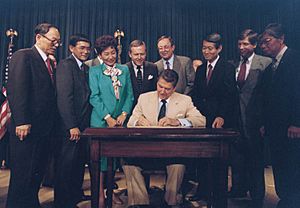Civil Liberties Act of 1988 facts for kids
 |
|
| Enacted by | the 100th United States Congress |
|---|---|
| Citations | |
| Public law | Pub.L. 100-383 |
| Statutes at Large | 102 Stat. 903 |
| Legislative history | |
|
|
The Civil Liberties Act of 1988 is a U.S. federal law that gave money and an apology to Japanese Americans. These were people who had been forced into special camps by the United States government during World War II. This act is also known by its public law number, Pub.L. 100-383.
The law was supported by people like Norman Mineta, a congressman from California. He himself had been in one of these camps. Senator Alan K. Simpson from Wyoming and Senator Pete Wilson from California also supported it. President Ronald Reagan signed the act into law.
The act gave each surviving person who had been in the camps $20,000. This money was called "reparations," which means making up for a past wrong. Payments started in 1990. The law officially said that the government's actions were based on "race prejudice, war hysteria, and a failure of political leadership." This meant it wasn't for real security reasons. In total, 82,219 people received these payments.
Some people of Japanese heritage from Latin American countries were also taken from their homes. They were not covered by this law at first because they were not U.S. citizens. Later, in 1996, a lawsuit helped some of them get about $5,000 each.
Contents
Why the Act Was Needed
Japanese American Internment During WWII
During World War II, about 120,000 Japanese Americans were forced to leave their homes. They were sent to special camps in remote areas. Most of these people (62%) were U.S. citizens.
Right after the attack on Pearl Harbor, the FBI arrested about 5,500 Japanese American men. They were sent to camps run by the Department of Justice. Others were able to move voluntarily. But over 110,000 men, women, and children were sent to "relocation centers." These were quickly built camps run by the War Relocation Authority (WRA).
President Franklin D. Roosevelt signed Executive Order 9066. This order allowed military leaders to create "military areas" where certain people could be excluded. This power was used to remove all people of Japanese ancestry from the entire Pacific coast. This included parts of Alaska, California, Oregon, Washington, and Arizona.
In 1944, the Supreme Court said these exclusions were legal. They argued that it was okay to limit the rights of a racial group if there was a "pressing public necessity."
Seeking Justice and Reparations
After the war, some money was paid for property losses in 1948. But most people could not get back all they had lost. In the 1960s and 1970s, Japanese Americans started a new movement. They wanted to get proper justice for being put in the camps.
The Japanese American Citizens League (JACL) began working to get individual reparations. In 1980, Congress created a special committee. This was called the Commission on Wartime Relocation and Internment of Civilians (CWRIC). Its job was to study what happened during the internment.
The CWRIC held hearings in 11 U.S. cities. More than 750 people shared their stories. In 1983, the commission released a report called Personal Justice Denied. It stated that the forced removal of Japanese Americans was due to "race prejudice, war hysteria and a failure of political leadership." The report recommended that former internees receive money.
A bill was introduced in 1987 to apologize and follow the CWRIC's recommendations. President Reagan and some Senate Republicans were against it because of the cost. But the bill was signed into law on August 10, 1988.
On October 9, 1990, the first reparations checks were given out. Nine elderly Japanese Americans received $20,000 each. They also received a formal apology signed by President George H. W. Bush. The United States Attorney General Dick Thornburgh presented the checks. He even knelt to reach those in wheelchairs.
Payments continued until 1993. The Office of Redress Administration managed these payments. Another agency, the Civil Liberties Public Education Fund, was created. Its goal was to teach the public about the internment. This was to prevent similar events from happening again.
What the Civil Liberties Act Does

The Civil Liberties Act of 1988 has several important goals:
- It officially recognizes that the forced removal and confinement of U.S. citizens and permanent residents of Japanese heritage during World War II was wrong.
- It offers an apology from the people of the United States for these actions.
- It creates a fund to educate the public about the internment. This helps prevent similar events from happening again.
- It provides money to those of Japanese heritage who were put in the camps.
- It also provides money to Aleut residents from certain islands. They suffered hardships and lost property during World War II.
- It aims to stop similar injustices and violations of civil liberties in the future.
- It makes the United States more believable when it speaks out against human rights violations by other countries.
Support and Opposition in Congress
The bill faced different levels of support in Congress.
On September 17, 1987, the U.S. House of Representatives voted on the bill. It passed with 243 votes in favor and 141 against. Most Democrats in the House voted for the bill (180 in favor). Most Republicans voted against it (98 opposed).
On April 20, 1988, the U.S. Senate voted on the bill. It passed with 69 votes in favor and 27 against. A large majority of Democrats voted for the bill (44 in favor). A smaller majority of Senate Republicans also voted for the bill (25 in favor).

